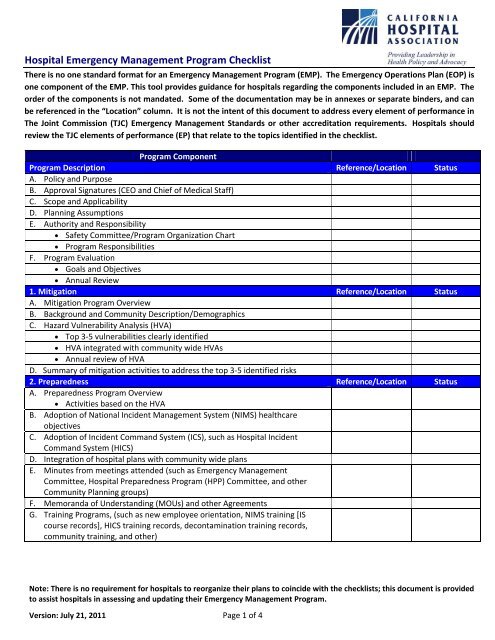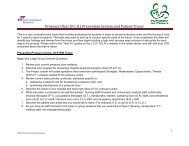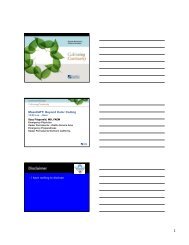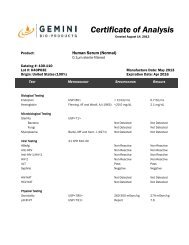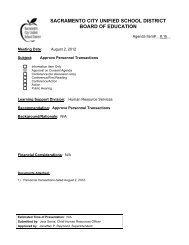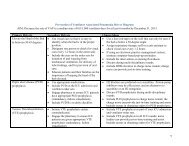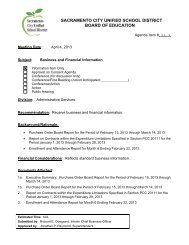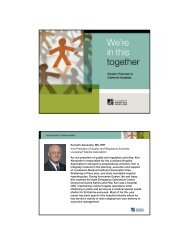Hospital Emergency Management Program Checklist
Hospital Emergency Management Program Checklist
Hospital Emergency Management Program Checklist
You also want an ePaper? Increase the reach of your titles
YUMPU automatically turns print PDFs into web optimized ePapers that Google loves.
<strong>Hospital</strong> <strong>Emergency</strong> <strong>Management</strong> <strong>Program</strong> <strong>Checklist</strong>2. Preparedness (continued) Reference/Location StatusH. Documentation of Drills/Exercises Exercise summaries Incident Action Plans Evaluation (After Action Reports) Improvement Plans (Corrective Action Plans)I. Business Continuity/Continuity of Operations Plan (COOP) Identify essential functions, systems, skill sets and responseassignments COOP for essential functions and systems (such as back-upfacilities/systems, telecommuting, etc) Note: The hospital COOP doesnot have to be incorporated into the EMP but should be referenced)3. Response (EOP) Reference/Location StatusA. Response <strong>Program</strong> OverviewB. Initiation and Termination of the <strong>Emergency</strong> Operations PlanC. Activation of the <strong>Hospital</strong> Command Center (HCC)D. HICS reference materials Job Action Sheets Incident Planning Guides Incident Response Guides HICS forms - Incident Action Plan and Incident DocumentationE. <strong>Hospital</strong> <strong>Emergency</strong> CodesF. Specific Response Plans including top 3-5 HVA vulnerabilities (such asearthquake, evacuation, pandemic). Event specific plans may beincorporated into the EOP, be an addendum to the EOP, or may include aseries of policies, procedures and protocols referenced in the EOPG. <strong>Hospital</strong> Surge/Expansion plans (see CHA Surge Planning <strong>Checklist</strong>)H. Describe plans/agreements, if any, the hospital has to deploy clinicalresources outside of the hospital (such as field triage/treatment teams)I. 96-Hour Capability (can be incorporated into the 6 critical areas sections) Identify hospital capabilities and establish response procedures whenthe hospital cannot be supported by the local community for at least96 hours (capabilities may include communication, resources,utilities, staff, safety and security) Document response procedures (such as maintaining/expandingservices, conservation of resources, curtailment of services,supplementing resources from outside disaster area, partial/stagedevacuation, or full evacuation, as necessary)J. Communications Systems (primary and redundant) (may be incorporated intothe Communications Strategies sections) California Health Alert Network (CAHAN) HAM radio EMSystem, Reddinet Other tools (phones, cell phones, satellite, email, pagers, radios, etc.)Note: There is no requirement for hospitals to reorganize their plans to coincide with the checklists; this document is providedto assist hospitals in assessing and updating their <strong>Emergency</strong> <strong>Management</strong> <strong>Program</strong>.Version: July 21, 2011 Page 2 of 4
<strong>Hospital</strong> <strong>Emergency</strong> <strong>Management</strong> <strong>Program</strong> <strong>Checklist</strong>3. Response (continued) (EOP) Reference/Location StatusK. <strong>Emergency</strong> Communications Strategies1. Staff notification that emergency response procedures have been initiated2. Ongoing communications with Staff/Medical Staff3. Communication with community (EOC/DOC, other healthcare facilities, etc.) <strong>Hospital</strong> status/capacity Event management Patient management Resource requesting/sharing Patient/Victim tracking4. Communication with patients and their families (including patientrelocation information)5. Communication with the Media6. Communication with supply, service and equipment vendors (includingafterhours/holidays)7. Communication and contact information for other healthcareorganizations8. Circumstances in which patient names/information will be shared withThird Parties (community partners) and how9. Communication with Alternative Care Sites (such as hospital expansionsites and government authorized Alternate Care Sites)L. <strong>Management</strong> of Resources and Assets1. Inventory/acquisition/monitor/replenishment of assets and resourcesfrom vendors, partners or caches(such as fuel, food/water,pharmaceuticals, medical supplies/equipment, linens, personal protectiveequipment)2. Sustainability of operations with external support3. How the organization will share resources and assets with otherhealthcare organizations4. <strong>Hospital</strong> Resource Directory (HICS Form 258)5. Transporting patients, records, staff, supplies during an evacuationM. <strong>Management</strong> of Safety and Security1. Establishment of internal safety and security2. Control access and movement (people and vehicles)3. Roles and coordination of security activities with community agencies(Private Security Services, Law Enforcement, National Guard)4. <strong>Management</strong> of hazardous materials and waste5. Provision for Radioactive Biological/Chemical isolation anddecontaminationN. <strong>Management</strong> of Workforce Roles and Responsibilities1. Define Staff/Medical Staff roles and responsibilities during an activation2. Process for assigning staff to essential functions3. Reporting instructions4. Staff support (such as food, water, hygiene, respite, medical, behavioralhealth, dependent care, housing/shelter, family plans, pet care)5. Staff Training6. Written communication with Medical Staff regarding their roles andreporting instructionsNote: There is no requirement for hospitals to reorganize their plans to coincide with the checklists; this document is providedto assist hospitals in assessing and updating their <strong>Emergency</strong> <strong>Management</strong> <strong>Program</strong>.Version: July 21, 2011 Page 3 of 4
<strong>Hospital</strong> <strong>Emergency</strong> <strong>Management</strong> <strong>Program</strong> <strong>Checklist</strong>7. <strong>Emergency</strong> credentialing of Licensed Independent Practitioners8. Acceptance and use of staff from other healthcare organizations9. Acceptance and use of volunteers (clinical and non-clinical)10. Identification of workforce (such as ID badges, vests, wristbands)O. <strong>Management</strong> of Utilities, provision, sustainability, and alternate means ofproviding:1. Electricity2. Potable Water3. Non-Potable Water4. Fuel5. Medical Gas/Vacuum systems6. Other essential utilities (vertical and horizontal transport, heating andcooling systems, steam for sterilization)P. <strong>Management</strong> of Clinical and Support Activities1. <strong>Management</strong> of patient clinical activities (such as Triage, Treatment Areas,Scheduling, Admission, Potential rapid discharge and transfer)2. Evacuation (see CHA Evacuation <strong>Checklist</strong>)3. Surge activities such as creating surge beds, cohorting patients, cancelingelective procedures , etc. (see CHA Surge Planning <strong>Checklist</strong>)4. Clinical services for Vulnerable Populations5. Patient hygiene and sanitation needs6. Patient behavioral health needs7. Decedent management/Mass Fatality procedures (see CHA Mass Fatality<strong>Checklist</strong>)8. Documentation and tracking of patient clinical and other information4. Recovery Reference/Location StatusA. Initiation of demobilization/recovery activities (planning may be initiatedduring Response Phase)B. Return to normal operations (phased, approvals, priorities, checklists)C. Event Evaluation1. Multi-disciplinary Incident Debriefing2. Evaluation of Response Plans (After Action Reports)3. Improvement plans/EOP update (Corrective Action Plans)Note: There is no requirement for hospitals to reorganize their plans to coincide with the checklists; this document is providedto assist hospitals in assessing and updating their <strong>Emergency</strong> <strong>Management</strong> <strong>Program</strong>.Version: July 21, 2011 Page 4 of 4


